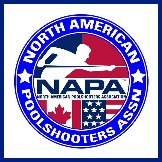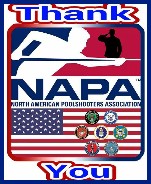Ball in Hand?
Pool League Information > Rules
WHEN DO YOU GET BALL IN HAND?
I don't know how many times I have been asked this question. It is a VERY important question. It can mean the difference between winning and losing a game or match.
Every player should know the rules but sometimes, especially when you play in multiple leagues, the rules seem to be unclear or confusing. I will attempt to clear up any confusion but giving you a handy dandy "cheat" sheet on when you get ball in hand.
In NAPA, as in most leagues, when you commit a foul you give ball in hand to your opponent. What this means is your opponent, due to your foul, gets to place the cue ball anywhere on the table, except on the break, to start their turn.
Here is a list of times your opponent gets ball in hand in NAPA. The applicable rule follows the comment if you want to look it up. If you want to print it you can find a PDF HERE.
Breaking
•Not a legal break (not hitting the 1 ball first in 9 ball), cue ball in hand behind the head string 1.6.2
•Not a legal break (pocket a ball or 4 balls to a rail), cue ball in hand behind the head string 1.8.1
• Cue ball pocketed on the break, cue ball in hand behind the head string 1.8.1
• Cue ball driven off the table, cue ball in hand behind the head string 1.8.2
• Object ball driven off the table, cue ball in hand behind the head string and object ball spotted 1.8.3
In the course of the game
• Hitting the 8 ball first on a combination is cue ball in hand. 1.10, 1.14
• If a shooter pockets an object ball and scratches, it is ball in hand. 1.10
• A shooter must hit his category of balls first. If not it is ball in hand. 1.11
• In shooting, an object ball or the cue ball must contact a cushion after initial contact with an object ball. 1.11
• If, during the placement of the cue ball in ball in hand situations, the arm or hand comes in contact with another ball, it is ball in hand 1.13, 3.3.1
• If the shooter touches the cue ball with the ferrule of the cue stick it is ball in hand. 1.1.3
• If the shooter scratches while shooting the 8 ball but the 8 ball is NOT pocketed, it is ball in hand. 1.16
• Telling your teammate which category of balls he or she has is a foul and it is ball in hand. 2.1
• Touching or causing the slightest movement of the cue ball (other than a normal shot) is ball in hand. 3.1
• Touching a moving object ball is a ball in hand foul. 3.3.2
• Accidently pocketing a ball by hand or stick or any part of the shooters body is ball in hand AND loss of turn. 3.3.4
• If the shooter makes a shot and after the shot is made makes contact with the cue ball before it comes to rest, it is ball in hand. 3.2
• Any ball accidently moved can only be replaced by the opponent. If the shooter touches any of the disturbed balls without consent of the opponent, it is ball in hand. 3.3.3
• Pocketing the cue ball is ball in hand. 3.5
• If the first ball contacted by the cue ball is not from the shooters established group it is ball in hand. 3.6
• If after the cue ball strikes a legal hit and neither the cue ball or any other ball hits a cushion or is pocketed it is ball in hand. 3.7
• If any ball, other than the 8 ball, is jumped off the table it is ball in hand AND loss of turn. Ball is spotted. If it was the 8 ball it is loss of game. 3.8
• If any ball is jumped off the table and hits something (a person, etc) that brings it back onto the table is a ball in hand. Table remains as it is. 3.9
• Not having one foot on the floor while shooting is a ball in hand foul unless a physical handicap or limitation is involved. 3.10
• In jumping a ball a legal jump shot must be made. No scooping or miscues. Ball in hand. 3.11, 9.5
• Jump cues are allowed but using a half cue or just a shaft is ball in hand. 4.6
• Shooting while any ball is moving or spinning is a ball in hand foul. 3.12
• All double hits are ball in hand fouls. If there is separation between the balls equal to or less than the width of a piece of chalk the shooter MUST keep from double hitting the cue ball. To avoid a double hit elevate the cue to a 45 degree angle. If balls are frozen no double hit can be called. If the distance is greater than the width of a piece of chalk any double hit is a ball in hand. If a third party is not called it is the shooters decision. Recommend a third party to watch to avoid controversy. 3.13, 9.8
• Using an out of play ball to measure gaps or spaces is a ball in hand foul. 3.16
• Taking more time to shoot than allowed is a ball in hand foul. NAPA allows 60 seconds to execute each shot. A first warning must be given. After a first warning is given a shot clock can be instituted. 3.17, 9.1
• Using a laser sight will result in loss of turn and ball in hand. 4.4
• If the shooter proceeds with their next shot after having been asked by the opponent to wait, it is a ball in hand foul. If the opponent does not dispute the shot before the next shot is played it is assumed a legal shot. 9.7
Timeouts
• If a time out is not available but a time out is taken, it is a ball in hand. 2.1
• If the coach marks any part of the table with chalk or another object, it is ball in hand. 2.3
• If the coach touches any ball, other than the cue ball, at any time, it is ball in hand. 2.3
• If the shooter’s time out exceeds one minute, it is ball in hand. 2.4
When is it loss of turn and NOT Ball in Hand in NAPA?
On some infractions it does NOT result in ball in hand. Here are some instances of when it is a loss of turn but NOT ball in hand.
Calling your pocket
• If the shooter does not call their intended object ball and pocket when performing a bank shot, a kick shot, a jump shot, a masse shot, or a combo shot, it is loss of turn. However, for obvious shots the ball and pocket does not have to be called. But to be safe, ALWAYS call ball and pocket because if it is clear to you what you are doing it may not be clear to your opponent. 1.2
• If the shooter pockets a ball in any other pocket than the called pocket it is not ball in hand. 1.2.
Breaking
• If the base of the cue ball in not behind the head string it is not ball in hand but a foul and a loss of turn. 1.7, 3.14
When is it a LOSS of GAME?
• If 8 ball jumps off the table, it is loss of game. 1.17, 3.8
• If 8 ball is moved accidently either by hand, stick or body, AND the 8 ball is pocketed as a result, it is loss of game for shooter causing foul. 3.4
• If 8 ball is pocketed in any pocket other than the intended pocket it is loss of game. 1.16, 1.17
• If 8 ball is made in intended pocket but shooter scratches, it is loss of game. 1.16
• If you make the 8 ball on the same stroke as the last of his group. 1.17
• If you pocket the 8 ball when it is not the legal object ball. 1.17
Answers to little know rules
• BASE of cue ball must be behind the head string for the break. 3.14
• ANY outside balls, including red dot cue balls, must be agreed upon by both teams. 4.5
• After 3 consecutive turns at the table by each player, both SHOOTERS agree to restart the game with the original breaker breaking again. 1.18
• The coach can change at any time. 2.1
• If a time out is called it must be taken. This includes any mention of a time out such as “want to talk about it” 2.1
• If the cue ball is frozen to the object ball, pushing through the cue ball is legal. 9.3
• If you intend to do a safety but do not call a safety, and make a ball, you MUST shoot again. 9.6
• Any forfeited matches will be AFTER all other matches have been played. 9.14


